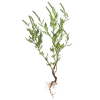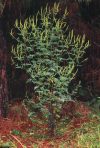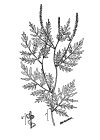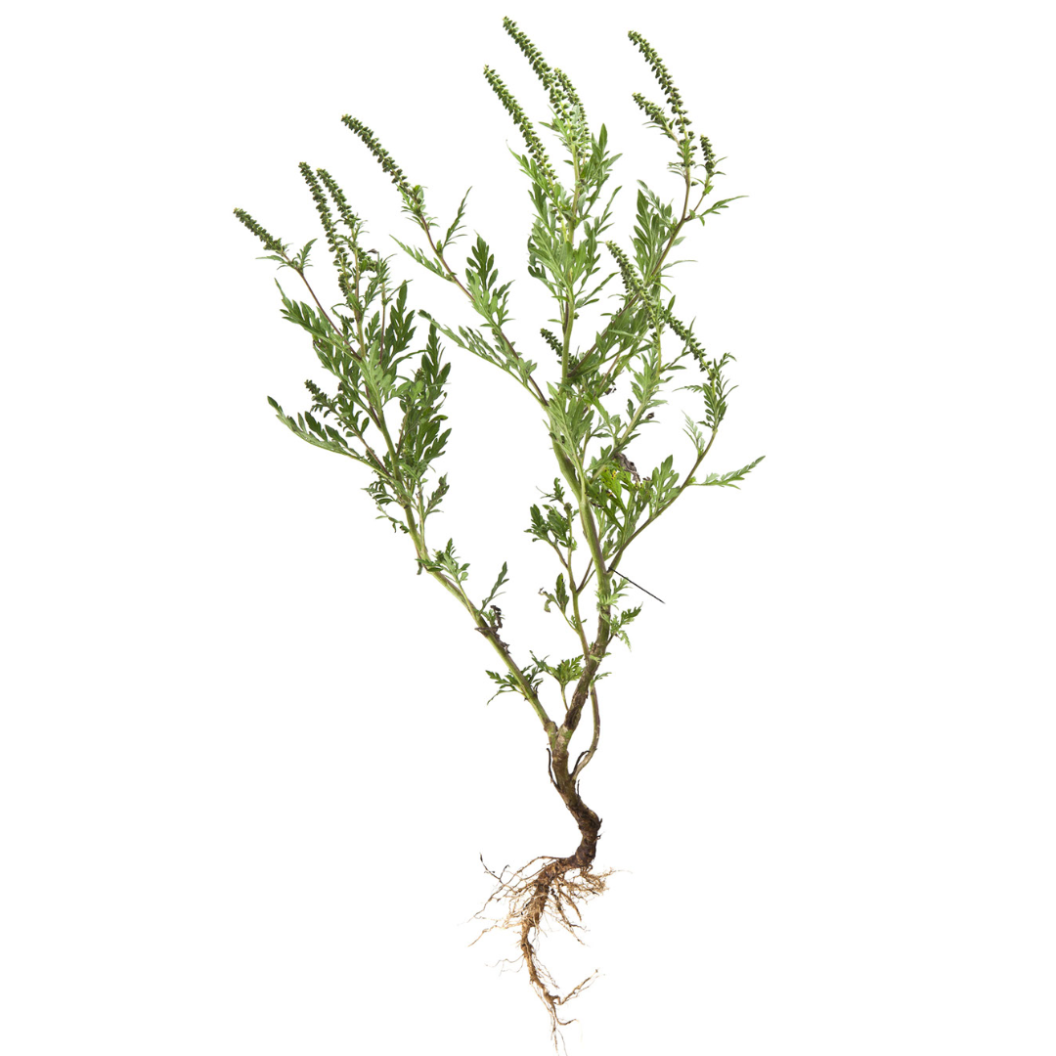







Ragweed
DESCRIPTION: Ragweed is a type of plant that can be found in many parts of the world, especially in North America. It usually grows in fields, meadows, and along roadsides, and it's quite tall and bushy with green leaves and stems. One thing that makes ragweed stand out is that it produces a lot of pollen, which can cause allergy symptoms like sneezing, runny nose, and itchy eyes in many people. In fact, ragweed pollen is one of the most common triggers of seasonal allergies.
SCIENTIFIC NAME: Ambrosia artemisiifolia
OTHER NAMES: Hay Fever Weed, Bitterweed, Bloodweed, Hogweed, Roman Wormwood, Wild Tansy
LEAF TYPE: Broadleaf
FLOWERS: Ragweed flowers are small and not very noticeable, with a greenish-yellow color. They grow in clusters on the ends of the plant's branches, and each flower has a spiky appearance due to its tiny, pointed petals. If you look closely, you can see that the flowers are made up of several tiny parts, including a central disk surrounded by many small stamens.
LEAVES: Ragweed leaves are long and narrow, with many deep lobes that give them a feathery appearance. They are usually green in color and have a slightly fuzzy texture. Interestingly, the leaves of ragweed somewhat resemble those of a fern, with their multiple lobes that create a delicate, intricate pattern. The leaves are attached to the stem alternately, meaning they grow from opposite sides of the stem, and they become smaller and less lobed as they approach the top of the plant. The overall effect is a bushy, slightly wispy appearance that can be quite attractive to some people, even though ragweed is often considered a pesky weed.
LIFE CYCLE: Annual
HOW TO IDENTIFY: Ragweed is a tall, bushy plant that can grow up to 5 feet tall and has multiple branches that give it a bushy appearance. Its leaves are long and narrow with many deep lobes that give them a feathery look, somewhat resembling fern leaves. The stem and leaves of ragweed have a slightly fuzzy or rough texture. Ragweed flowers are greenish-yellow and grow in clusters on the ends of the branches. Although not very noticeable, they are important in the plant's reproduction by attracting pollinators. Ragweed typically blooms in late summer and early fall, so keep an eye out for it during this time of year. A unique feature of ragweed is that it can cause allergic reactions in many people, so rubbing the leaves can be a good way to see if you have found ragweed. If you start sneezing or your eyes start itching, there's a good chance you've found ragweed.
MECHANICAL CONTROL RECOMMENDATIONS:
1. Hand pulling - More Info
2. Mowing - More Info
3. Tilling or Cultivation - More Info
4. Mechanical Weed Removal Tools - More Info
5. Mulching - More Info
6. Flame Weeding - More Info
7. Machinery - More Info
CHEMISTRY RECOMMENDATIONS:
"Pre-emergent herbicides:
Atrazine: Atrazine is a widely used pre-emergent herbicide that can provide effective control of common ragweed when applied before germination. It's important to follow label instructions and consider any environmental and regulatory restrictions associated with its use.
Isoxaben: Isoxaben is another pre-emergent herbicide that can be effective against common ragweed. It's often found in herbicide formulations used for controlling broadleaf weeds.
Dithiopyr: Dithiopyr is a selective pre-emergent herbicide that can offer control against common ragweed. It's often used in turfgrass and ornamental plant settings.
Pendimethalin: Pendimethalin is known for its broad-spectrum pre-emergent weed control, and it can be effective against common ragweed. It's commonly used in agricultural and landscape settings.
Prodiamine: Prodiamine is effective against a range of annual grasses and broadleaf weeds, including common ragweed. It's often used in lawns, ornamental beds, and golf courses.
Oryzalin: Oryzalin is used to control a variety of annual grasses and broadleaf weeds. It can provide pre-emergent control of common ragweed in various settings.
Trifluralin: Trifluralin is a pre-emergent herbicide that can be effective against common ragweed. It's often used in agricultural and horticultural applications.
Post-emergent herbicides:
Glyphosate: Glyphosate is a non-selective post-emergent herbicide that can effectively control a wide range of weeds, including common ragweed. It's commonly used in non-crop areas and can be used to spot-treat individual ragweed plants.
2,4-D: 2,4-D is a selective post-emergent herbicide that targets broadleaf weeds. It can provide effective control of common ragweed in lawns, turfgrass, and other managed areas.
Dicamba: Dicamba is another selective post-emergent herbicide used to control broadleaf weeds, including common ragweed. It's often used in agricultural and residential settings.
Metsulfuron: Metsulfuron is a systemic post-emergent herbicide that can control a variety of broadleaf weeds, including common ragweed. It's commonly used in turfgrass and non-crop areas.
Clopyralid: Clopyralid is a selective post-emergent herbicide that targets broadleaf weeds. It can provide control of common ragweed in certain turfgrass and agricultural settings.
Triclopyr: Triclopyr is effective against a range of broadleaf weeds, including common ragweed. It's commonly used in turfgrass, ornamental beds, and rights-of-way.
Aminopyralid: Aminopyralid is a selective post-emergent herbicide that can provide control of certain broadleaf weeds, including common ragweed. It's often used in pastures and non-crop areas.
Fluroxypyr: Fluroxypyr is another selective post-emergent herbicide used to control broadleaf weeds. It can be effective against common ragweed in certain settings.
Selective herbicides:
2,4-D: 2,4-D is a selective herbicide that targets broadleaf weeds, making it effective against common ragweed. It's commonly used in lawns, turfgrass, and other managed areas.
Dicamba: Dicamba is another selective herbicide used to control broadleaf weeds, including common ragweed. It's used in various agricultural and residential settings.
MCPA: MCPA is a selective herbicide that targets broadleaf weeds and is often used in lawns, golf courses, and other turfgrass areas.
Triclopyr: Triclopyr is effective against a range of broadleaf weeds, including common ragweed. It's used in turfgrass, ornamental beds, and rights-of-way.
Clopyralid: Clopyralid is a selective herbicide that targets broadleaf weeds and can provide control of common ragweed in certain settings.
Aminopyralid: Aminopyralid is a selective herbicide used to control certain broadleaf weeds, including common ragweed. It's used in pastures, rangeland, and non-crop areas.
Fluroxypyr: Fluroxypyr is effective against a range of broadleaf weeds, including common ragweed. It's used in various turfgrass and non-crop settings.
Quinclorac: Quinclorac is commonly used in controlling broadleaf weeds in turfgrass and can be effective against common ragweed.
Sulfentrazone: Sulfentrazone is a selective herbicide that targets a variety of broadleaf weeds, including common ragweed. It's often used in turfgrass and ornamental settings.
Non-Selective herbicides:
Glyphosate: Glyphosate is one of the most widely used non-selective herbicides. It's effective against a broad range of weeds, including common ragweed. It's often used for spot treatments or in areas where you want to clear vegetation completely, such as in industrial sites or preparing a field for planting.
Glufosinate: Glufosinate is another non-selective herbicide that can be used to control common ragweed. It's used in various agricultural, horticultural, and non-crop settings.
Diquat: Diquat is a fast-acting non-selective herbicide often used for burndown or desiccation purposes. It can provide control of common ragweed and other weeds.
Paraquat: Paraquat is a non-selective herbicide that acts quickly to desiccate and kill vegetation on contact. It can be used for spot treatments and in areas where complete vegetation removal is desired.
Pelargonic Acid (Fatty Acid-Based Herbicides): These herbicides are derived from fatty acids and work by disrupting the cell membranes of plants. They can provide effective control of common ragweed and other weeds.
Sodium Chlorate: Sodium chlorate is a non-selective herbicide that can be used for total vegetation control. It's often used in industrial or non-crop areas.
Imazapyr: Imazapyr is a non-selective herbicide used for total vegetation control in areas such as industrial sites, rights-of-way, and bare ground areas.
Recommended Prevention
Recommended Control

